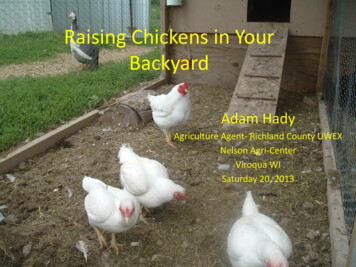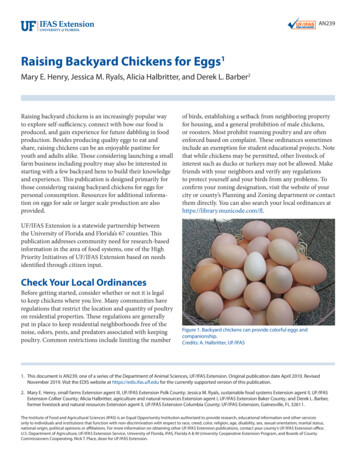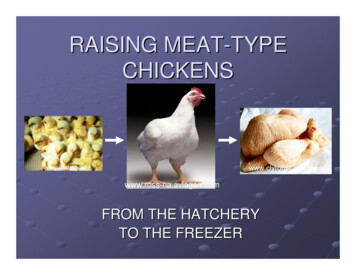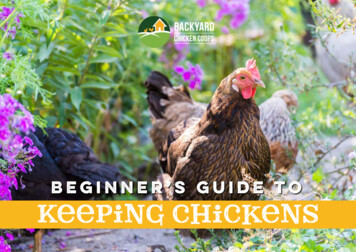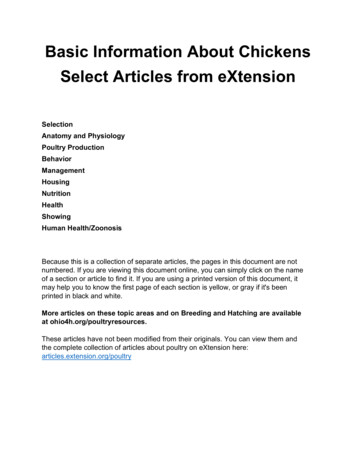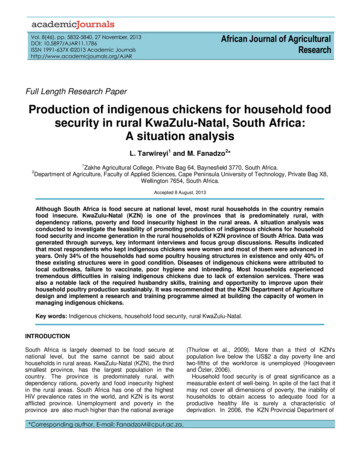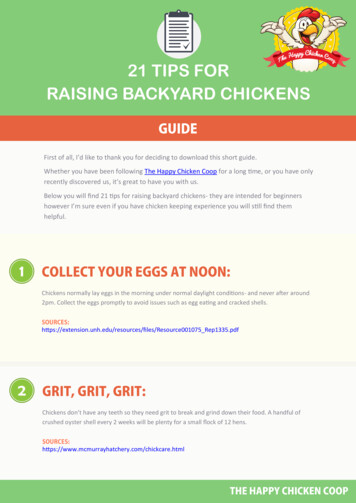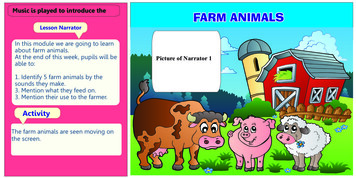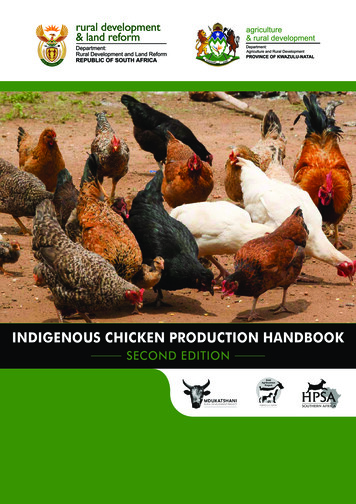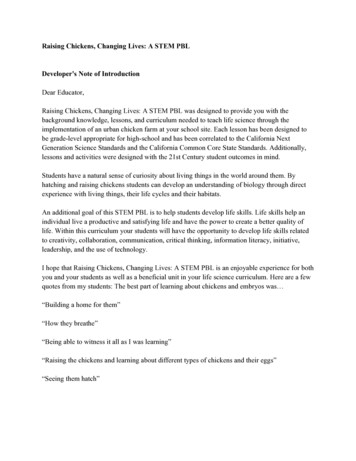
Transcription
Raising Chickens, Changing Lives: A STEM PBLDeveloper's Note of IntroductionDear Educator,Raising Chickens, Changing Lives: A STEM PBL was designed to provide you with thebackground knowledge, lessons, and curriculum needed to teach life science through theimplementation of an urban chicken farm at your school site. Each lesson has been designed tobe grade-level appropriate for high-school and has been correlated to the California NextGeneration Science Standards and the California Common Core State Standards. Additionally,lessons and activities were designed with the 21st Century student outcomes in mind.Students have a natural sense of curiosity about living things in the world around them. Byhatching and raising chickens students can develop an understanding of biology through directexperience with living things, their life cycles and their habitats.An additional goal of this STEM PBL is to help students develop life skills. Life skills help anindividual live a productive and satisfying life and have the power to create a better quality oflife. Within this curriculum your students will have the opportunity to develop life skills relatedto creativity, collaboration, communication, critical thinking, information literacy, initiative,leadership, and the use of technology.I hope that Raising Chickens, Changing Lives: A STEM PBL is an enjoyable experience for bothyou and your students as well as a beneficial unit in your life science curriculum. Here are a fewquotes from my students: The best part of learning about chickens and embryos was “Building a home for them”“How they breathe”“Being able to witness it all as I was learning”“Raising the chickens and learning about different types of chickens and their eggs”“Seeing them hatch”
California State Standards AlignmentNext Generation Science StandardsHS-LS1-4: Use a model to illustrate the role of cellular division (mitosis) and differentiation inproducing and maintaining complex organisms. (LS1.B)HS-LS3-1: Ask questions to clarify relationships about the role of DNA and chromosomes incoding the instructions for characteristic traits passed from parents to offspring. (LS1.A andLS3.A)HS-LS3-2: Make and defend a claim based on evidence that inheritable genetic variations mayresult from: (1) new genetic combinations through meiosis, (2) viable errors occurring duringreplication, and/or (3) mutations caused by environmental factors. (LS3.B)HS-ETS1-2: Design a solution to a complex real-world problem by breaking it down intosmaller, more manageable problems that can be solved through engineering.HS-ETS1-3: Evaluate a solution to a complex real-world problem based on prioritized criteriaand trade-offs that account for a range of constraints, including cost, safety, reliability, andaesthetics as well as possible social, cultural, and environmental impacts.Common Core: English Language ArtsRST.11-12.1: Cite specific textual evidence to support analysis of science and technical texts,attending to important distinctions the author makes and to any gaps or inconsistencies in theaccount. (HS-LS3-1),(HS-LS3-2)RST.11-12.9: Synthesize information from a range of sources (e.g., texts, experiments,simulations) into a coherent understanding of a process, phenomenon, or concept, resolvingconflicting information when possible. (HS-LS3-1)SL.11-12.5: Make strategic use of digital media (e.g., textual, graphical, audio, visual, andinteractive elements) in presentations to enhance understanding of findings, reasoning, andevidence and to add interest. (HS-LS1-4)SL. 9-10, 11-12.6: Adapt speech to a variety of contexts and tasks, demonstrating a command offormal English when indicated or appropriate.WHST.9-12.1: Write arguments focused on discipline-specific content. (HS-LS3-2)WS 11-12.6: Use technology, including the Internet, to produce, publish, and update individualor shared writing products in response to ongoing feedback, including new arguments orinformation.WS 11-12.7: Conduct short as well as more sustained research projects to answer a question(including a self-generated question) or solve a problem; narrow or broaden the inquiry when
appropriate; synthesize multiple sources on the subject, demonstrating understanding of thesubject under investigation.Common Core: MathematicsMP.2: Reason abstractly and quantitatively. (HS-LS3-2),(HS-LS3-3)MP.4: Model with mathematics. (They are able to identify important quantities in a practicalsituation and map their relationships using such tools as diagrams, two-way tables, graphs,flowcharts and formulas.) (HS-LS1-4)21st Century Student OutcomesLearning & Innovation Skills:Creativity, Critical Thinking, Communication, CollaborationInformation Literacy:Access and Evaluate Information, Use and Manage InformationLife & Career Skills:Flexibility & Adaptability, Initiative & Self Direction, Social & Cross-Cultural Skills,Productivity & Accountability, Leadership & ResponsibilityCTE Building & Construction Trades2.0 Communications2.1 Recognize the elements of communication using a sender–receiver model.2.2 Identify barriers to accurate and appropriate communication.2.3 Interpret verbal and nonverbal communications and respond appropriately.2.4 Demonstrate elements of written and electronic communication such as accurate spelling,grammar, and format.2.5 Communicate information and ideas effectively to multiple audiences using a variety ofmedia and formats.4.0 Technology4.1 Use electronic reference materials to gather information and produce products and services.4.2 Employ Web-based communications responsibly and effectively to explore complex systemsand issues.4.3 Use information and communication technologies to synthesize, summarize, compare, andcontrast information from multiple sources.4.4 Discern the quality and value of information collected using digital technologies, andrecognize bias and intent of the associated sources.5.0 Problem Solving and Critical Thinking5.1 Identify and ask significant questions that clarify various points of view to solve problems.5.4 Interpret information and draw conclusions, based on the best analysis, to make informeddecisions.
PBL Design OverviewSTEM PBL Design OverviewTitle:Raising Chickens, ChangingLivesEst. Start Date:Duration: 7-10weeks ofcurriculum,ongoing PBL unitTeacher:Kathleen DennisContent Focus: Life ScienceGrade Level: 9-12Other subject areas to be included:Engineering, Mathematics, TechnologyOverall Idea:Students will study the structure and function of DNA, mitosis and the growth andSummary of the development of multicellular organisms, and the inheritance of traits throughissue,urban chicken farming.challenge,investigation,This STEM PBL is an integrated study of life science, engineering, mathematics,scenario, orand technology with a focus on presenting and student communication skills.problemThe Project:An education assortment of fertile eggs was purchased for this PBL from:What atching-Eggs/Hatching-Eggs-forstudents design, Education-p911.aspxbuild, and/orpresent at theStudents will begin the PBL by studying DNA, mitosis, and what chickens need toend of the PBL survive. When the eggs arrive they will research the types of eggs received (becauseto demonstrateit’s a surprise!) and begin incubation. Students will monitor the daily conditions intheir expertisethe incubator and begin designing a coop for the chickens. When a winning coopandhas been selected students will construct it and it will become the chickens newsolution/answer home when they are fully feathered. Students will continue to learn with this PBLto the Drivingas they now have a small chicken farm to maintain and eggs to collect!Question?EssentialDrivingIs it possible to design a selfQuestions:Questions: sustaining chicken farm in anWhat is mitosis?urban, high crime and povertyridden neighborhood?How are traits passed fromHow can chickens help us toparents to offspring?understand cell division, the roleof DNA and inheritance?Creativity21st CenturyCritical ThinkingSkills andMPS to beexplicitly taught CommunicationT AxExxT AEFlexibility & AdaptabilityxInitiative & Self DirectionxSocial & Cross-Cultural Skillsx
and assessed(T A) or thatwill beencouraged (E)by Project workbut not taughtor assessed:CollaborationAccess & EvaluateInformationUse & ManageInformationGroup:xxProductivity & AccountabilityxLeadership & ResponsibilityxxChicken coop, models, Google SlidespresentationCulminatingProducts andPerformancesClassPresentation AudiencexSchoolCommunityIndividual:Incubation journals and graphsExpertsxWebOther:Project OverviewEntry eventto launchinquiry, engagestudents:What comes first, the chicken or the egg? Without any access to technologystudents will work in small groups to make a claim with evidence and present theirclaim to the class. There are many theorized answers to this ancient question, buthere is one that is widely accepted:Explanation Video: https://www.youtube.com/watch?v 1a8pI65emDEOutline orConceptualFlowIncludeassessmentpoints andclearly identifyopportunity(s)for students toinquire,research, andshare their newknowledge withtheir peers.1. Students should know the structure and function of DNA.a. All cells contain genetic information in the form of DNA molecules.i. DNA is located in the nucleus of cellsii. DNA is a double helix formed by base pairs attached to a sugarphosphate backbone.iii. DNA can replicate itself.iv. DNA can be altered, genetically modified organismsb. Genes are regions in the DNA that contain the instructions that code forthe formation of proteins.i. A gene is the basic physical and functional unit of heredity.ii. Every person has two copies of each gene, one inherited fromeach parent.iii. The entire human genome has been mapped by the HumanGenome Project.
2. Students should know how organisms grow and develop.a. In multicellular organisms individual cells grow and then divide via aprocess called mitosis, thereby allowing the organism to grow.i. The major purpose of mitosis is for growth and to replace wornout cells.ii. There are 5 phases of mitosis, interphase, prophase, metaphase,anaphase, telophase.b. The organism begins as a single cell (fertilized egg) that dividessuccessively to produce many cells, with each parent cell passingidentical genetic material (two variants of each chromosome pair) to bothdaughter cells.i. Chromosomes are not visible in the cell’s nucleus—not evenunder a microscope—when the cell is not dividing.ii. Each chromosome has a constriction point called the centromere,which divides the chromosome into two sections, or “arms.”iii. Each chromosome is comprised of two chromatids afterinterphase.c. Cellular division and differentiation produce and maintain a complexorganism, composed of systems of tissues and organs that work togetherto meet the needs of the whole organism.3. Students should know how traits are inherited.a. Each chromosome consists of a single very long DNA molecule, andeach gene on the chromosome is a particular segment of that DNA.i. In humans, each cell normally contains 23 pairs of chromosomes,for a total of 46.b. The instructions for forming species’ characteristics are carried in DNA.i. The genotype of an individual influences their phenotypeii. Mendelian Inheritanceiii. Punnet squares can be used to predict an organism's genotype andphenotype.iv. Alleles are forms of the same gene with small differences in theirsequence of DNA bases. These small differences contribute toeach person’s unique physical features.v. Genetic diseases may be inherited.c. All cells in an organism have the same genetic content, but the genesused (expressed) by the cell may be regulated in different ways.i. Homeobox genes produce basic body parts in all animals.ii. Genes respond to environmental factors.iii. Some consequences of gene regulation are cancer, disease, aging,and obesity.
d. Not all DNA codes for a protein; some segments of DNA are involved inregulatory or structural functions, and some have no as-yet knownfunction.i. 98% of DNA is Noncoding DNAAssessmentsFormativeAssessments(During Project)Quizzes/TestsxJournaling/Learning LogPreliminary Plans/OutlinesxRough DraftsOtherSummativeAssessments(End of Project,identify contentareas to becovered)NOTE: The endof PBLSummativeAssessments doNOT replace TheProject.ResourcesNeededWritten Product(s), withrubricOther Products: ChickenCoopxxOral Presentation, withrubricxPeer EvaluationMultiple Choice/ShortAnswer TestxSelf-EvaluationEssay TestOtherOn-site people,facilitiesScience teacher, construction teacher or teacher withconstructions skills and time to implementEquipmentConstruction tools (saw, hammer, drills, etc.)Wood, chicken wire, screws, various building materials formodel coops, incubator, fertile chicken eggs, chicken food,wood shavings, 1:1 devices, Internet, paper, pencils, variousart materials. Various materials and art supplies are neededduring the 7 weeks of instruction, be sure to review the lessonahead of time (especially for activities) to make sure you haveall needed materialsCommunity resources Master gardener, feed store, chicken farmerMaterialsJournal/Learning LogxFocus Group
ReflectionMethods(Individual,Group, and/orWhole Class)Whole-class DiscussionxFishbowl DiscussionSurveyxOther: Inside /OutsideCirclexProject Teaching and Learning GuideKnowledge and Skills Needed by Students(to successfully complete culminating projects and to do well on summative assessments)Student needs to be able to:Clarify relationships about the role of DNA andchromosomes in coding the instructions forcharacteristics traits passed from parents tooffspring.Student needs to be able to:Illustrate the role of cellular division anddifferentiation in producing and maintainingcomplex organisms.Student needs to be able to:Provide evidence that inheritable geneticvariations may result from: new geneticcombinations through meiosis, viable errorsoccurring during replication, and/or mutationscaused by environmental factors.Student needs to be able to:Describe the necessary requirements for asuccessful egg incubation and the requirementsfor raising chickens.Student needs to be able to:Design and build a chicken coop by breaking theproblem down into smaller, more manageableengineering problems.Student needs to be able to:Weekly Lesson Plans
*Please note that it is very difficult to have set weekly lesson plans in project based learning aslearning takes it’s own course. Problems may arise or you may find that you want or need tospend more or less time on a topic. Please use the lesson guide below as a template that youmodify to the needs of your students and school site. Refer to Appendix A for the URL to accessthe direct links to the videos, activities, Google forms, and Kahoot Quizzes included in the lessonplans.Below are the lesson plans needed to teach the specified Next Generation Science Standards andlessons specific to the incubation, hatching, and raising of the chickens are not included.However, many embryology resources and links to already developed curriculum are includedon page 36 of this document. That along with Pinterest and a couple books from your locallibrary should be more than enough!*All lessons were designed to fit a 45 minute class period with a daily warm-up activity of theteachers choosing. Daily warm-up could assess prior knowledge of the intended objective, checkfor understanding, review of previously taught content, and/or be just for fun, such as a puzzle orriddle.**WHEN USING GOOGLE TEMPLATES PLEASE MAKE A COPY FIRST!! This willcreate a working copy for yourself that you may then edit without affecting the originaldocuments. Thank you!Week 1-3DNA, genes, and chromosomes (Structure and Function of DNA &Inheritance of Traits)Standard (DCI’s)- HS-LS3-1: Ask questions to clarify relationships about therole of DNA and chromosomes in coding the instructions for characteristictraits passed from parents to offspring. (LS1.A, LS3.A)Day 1Objective: What is DNA?Lesson: Have students fill out form worksheet while goingthrough the Khan Academy video. Encourage students to pauseand discuss with each other.Resources:Khan Academy deoxyribonucleic-acidGoogle Form XODF6h1i-
Q8txgJiN6SQFHkC-NcgW8T4 1 Q/edit?usp sharingDay 2Objective: What is complementary base pairing?Lesson: Students are given a single strand of DNA from a livingorganism of their choice and must follow complementary basepairing rules to complete a double stranded bracelet.Resources:Activity: Build a DNA ence-braceletsDay 3Objective: Where is DNA located?Lesson: Go through Journey Into DNA Flash media show withstudents and have them complete the Google form worksheet.After completing the worksheet have students use microscopes tolook at various cells. Good examples would be human bloodsmear, human spermatozoa, human muscle, and humancerebrum. Be sure to have students locate the nucleus of the cell,note differences between the tissues, and point out that the redblood cell does not contain a nucleus.Resources:Journey into DNA video, essay, and ogle Form Worksheet:https://docs.google.com/forms/d/1F5s7iX 2ZWrbAB 0id3jF-S54j3xSu0qCTJ6EdtTh8/edit?usp sharingDay 4Objective: Create an analogy for DNALesson: Review with students what the human genome is, have ashort group discussion and then have students work individuallyto create a class slideshow of different analogies for DNA.Resources:Human Genome definition and nomeGroup discussion: Scientists have likened the human genome to aparts list. Explain what they mean. Come up with your own analogyfor DNA.DNA Analogy Slides xW9rLLJ0OgmY-
NOQbLKEEbDJ6Cs -aCt-XnxPp 1sA/edit?usp sharingDay 5Objective: What is the Human Genome Project?Lesson: Introduce the Human Genome Project with a short videoand discussion questions, then have students explore the DNAsequencing process in the Flash media web activity. Have studentsrecord their discussion answers on the Google Form worksheet.Resources:Human Genome UrLrcSequence for Yourself Web /#.WV7FYtUrLrcGoogle Form CjFop6BkNJ RCtqrteyYkWuFWiEH419SKySM/edit?usp sharingDay 6Objective: How is DNA put together?Lesson: Let students review the structure and function of DNA inthis fun edible activity where students build a candy model of astrand of DNA. Afterwards students CFU with an interactivechallenge to build 3 unique strands of DNA and match them totheir owners based on the given information.Resources:Activity: Modeling DNA’s structure with 02.sci.life.repro.lp dnastructure/modeling-dna-structure/DNA ploads/2011/05/DNAFINAL.pngBuilding DNA ne/dna double helix/dnahelix.htmlDay 7Objective: Formative Assessment
Lesson: Kahoot! Quiz to CFU of Objectives: What is DNA?,What is complementary base pairing?, Where is DNA located?,and What is the Human Genome Project?Resources:Quiz -9496-61ecaf379ea0Day 8Objective: What are genes and chromosomes?Lesson: Have students review the information on genes andchromosomes and discuss what is a gene? What is a chromosome?Then have students work with a partner to explore chromosomepairs by making a karyotype and matching chromosomes. Afterletting students experience PTC paper and determine if they havethe gene that allows them to taste have them calculate whatpercentage of the class is a “taster”. On average 75% of peoplecan taste and 25% cannot. Discuss the results with your class bymaking a graph.Resources:Gene and chromosome information .htmlChromosome Karyotype Web sics/karyotype/PTC information and s/ptc/Day 9Objective: What are master control genes?Lesson: Students take a deeper look at genes and their origins.Begin the lesson by posing a questions and giving students time toformulate an answer with evidence: If identical twins have theexact same DNA, then why are they not 100% exactly the same?After discussing have students watch the video on epigenetics.Then have students work with a partner to watch the two videoson gene control and homeobox genes and answer thecomprehension questions on the Google Response Form.Resources:What is epigenetics? video:https://www.youtube.com/watch?v aAhcNjmvhc&t 107sGene Control 02.sci.life.cell.genecont
rl/gene-control/Homeobox gene ogle Response 7ZpwGIZr nRcvJ95crK698vP8ZZbLSg/edit?usp sharingDay 10Objective: What are Genetically Modified Organisms?Lesson: Split the class into 6 equal groups and assign each groupone of the 3 What would you do scenarios from the GMO foodinformation and facts webpage. Have them work together todecide what they would do and share with the class defendingtheir stance with specific reasons. Then assign pairs of students toa GMO Animal and complete their slide in the class slideshow.Resources:GMO food information and ce/gmfoods/Full Class GMO Animals Google Slides Presentation:1. Enviropig2. Web-Spinning Goats3. Fast Growing Salmon4. Less-Flatulent Cows5. Sudden Death Mosquitos6. Glittering Gold SeaHorses7. Mostly Male Tilapia8. Featherless Chicken9. Glow-in-the-Dark Rabbit and Cat10. Hypoallergenic Cat11. Super Cows12. Popeye PigsGoogle Slides 9j76GxCWVs3E10mFbnWTT9m cR7AWMcieQTRKaWFc/edit?usp sharingDay 11Objective: Should we create babies by design?Lesson: Have students work through whether they think in thefuture we should create designer babies. They will be presentedwith various pros and cons and asked the same question five
times. After going through the Flash web interactive students areasked write persuasively about their stance using the evidenceprovided.Resources:Lesson abies-by-design/Flash web interactive es/YouTube Video Tay Sachs:https://www.youtube.com/watch?v /edit?usp sharingDay 12Objective: What are traits and how are they inherited?Lesson: Pose an inheritance question to your students: How mightit be possible for you to have red hair, but both your mom anddad have brown hair? After discussing, have students visit thethree resources below, watch the videos, read the content, and fillout the Google Form Worksheet.Resources:Inheritance cs/inheritance/Ted Ed video on Mendel and Punnett squares:https://www.youtube.com/watch?v Mehz7tCxjSEMonohybrid cross video:https://www.youtube.com/watch?v i-0rSv6oxSYGoogle Form Fr7oMWl0ONZ0VRUCXkq7r-YT24uWKz2153-M/edit?usp sharingDay 13Objective: How do Punnett squares show probability ofinheritance?Lesson: After learning the basics of inheritance let studentsexplore making baby bunnies in this Punnett square game.
Resources:Furry Family Web interactive Punnett square ads/FurryFamily.swfOptional extension STEM resource: interactive web activity to breeddragons 17 levels of heredity and erseDay 14Objective: Extract real DNA from a strawberry!Lesson: Follow the instructions to help students extract andisolate DNA from strawberries using simple, householdingredients.Resources:Activity: DNA extraction iments/strawberrydna/Alternate Online DNA labs/extraction/Day 15Objective: Formative AssessmentLesson: Kahoot! Quiz to CFU of Objectives: What are genes andchromosomes?, What are Genetically Modified Organisms?,What are traits and how are they inherited?, and How do Punnettsquares show probability of inheritance?Resources:Quiz -bed5-f46610823868EnglishExtensionsNature vs nurture persuasive writingPros/Cons and ethics of nce/pharming/Week 4-5Cell division: Mitosis (Growth and Development of Organisms)Standard (DCI)- HS-LS1-4: Use a model to illustrate the role of cellulardivision (mitosis) and differentiation in producing and maintaining complexorganisms. (LS1.B)Day 1Objective: What is mitosis?Lesson: Introduce students to mitosis with the fun graphic
handout and let them work with a partner to study and color theimages. Then have students watch the mitosis video and fill outthe comprehension worksheet.Resources:Mitosis graphic handout: 0/82/9ef0824c0a0b09f4e4fcd23b1822104d.jpgMitosis Video:https://www.youtube.com/watch?annotation id annotation 3739956411&feature iv&src vid gwcwSZIfKlM&v f-ldPgEfAHIMitosis /9/0/21902384/video recap of mitosis by amoeba sisters.pdfDay 2Objective: Create a rubric for a stop-motion animation video ofthe process of mitosis.Lesson: Follow the tutorial to help students create a flat birds-eyeview stop-motion animation of mitosis using WeVideo. Showstudents example videos and create a rubric together as a classusing Rubistar. Let students ask questions about the project andlet them decide what they should be graded on. Students may getcreative and bring in their own supplies or you may choose toprovide colored paper, dried beans, markers, string, foil,playdough, etc.Resources:Tutorial: http://www.techmantraining.com/wevideo.htmlExample Videos: ch query mitosis stop motion animationRubistar ideo Website:https://www.wevideo.com/Day 3Objective: Create a stop-motion animation video of the process ofmitosis.Lesson: Pass out the stop-motion planning guide and storyboard
to students. Have them brainstorm ideas before getting studentsinto partners or groups to begin planning their videos. Then,introduce students to the importance of Storyboarding with thehow to storyboard video.Resources:How to storyboard your animation video:https://www.youtube.com/watch?v ji2nwkH2JRoStop-Motion Planning Guide & XOv9Iu0B0qFYesfNKdkGNlErH1QpeSKXQtU0BoCs/edit?usp sharingStop-motion planning guide and xBpgN URC07jCEPx3Sftn3BEe0Z0DvqDYJXjueC0/edit?usp sharingWeVideo:https://www.wevideo.com/Day 4Objective: Create a stop-motion animation video of the process ofmitosis.Lesson: Direct students to review the mitosis video from Day 1and have them take the photos for Interphase and Prophase.Additional Khan Academy videos on interphase and mitosis havealso been included for student review.Resources:Day 1 mitosis video:https://www.youtube.com/watch?annotation id annotation 3739956411&feature iv&src vid gwcwSZIfKlM&v f-ldPgEfAHIKhan Academy Interphase ells/cellulardivision/v/interphaseKhan Academy Mitosis ells/cellulardivision/v/mitosisWeVideo website:https://www.wevideo.com/Day 5Objective: Create a stop-motion animation video of the process ofmitosis.
Lesson: Direct students to review the mitosis video from Day 1and the Khan academy video and have them take the photos forMetaphase and Anaphase.Resources:Day 1 mitosis video:https://www.youtube.com/watch?annotation id annotation 3739956411&feature iv&src vid gwcwSZIfKlM&v f-ldPgEfAHIKhan Academy Mitosis ells/cellulardivision/v/mitosisWeVideo website:https://www.wevideo.com/Day 6Objective: Create a stop-motion animation video of the process ofmitosis.Lesson: Direct students to review the mitosis video from Day 1and the Khan Academy video, have them take the photos forTelophase and Cytokinesis and begin putting the clips together inWeVideo. Students will need to create accounts if they haven’talready.Resources:Day 1 mitosis video:https://www.youtube.com/watch?annotation id annotation 3739956411&feature iv&src vid gwcwSZIfKlM&v f-ldPgEfAHIKhan Academy Mitosis ells/cellulardivision/v/mitosisWeVideo website:https://www.wevideo.com/WeVideo Academy tutorials:https://www.wevideo.com/academyDay 7Objective: Create a stop-motion animation video of the process ofmitosis.Lesson: Have students put all clips in order, add music andtransitions, and perform video edits.Resources:
WeVideo:https://www.wevideo.com/WeVideo Academy tutorials:https://www.wevideo.com/academyDay 8Obj
Raising Chickens, Changing Lives: A STEM PBL Developer's Note of Introduction Dear Educator, Raising Chickens, Changing Lives: A STEM PBL was designed to provide you with the background knowledge, lessons, and curriculum needed to teach life science through the imp
